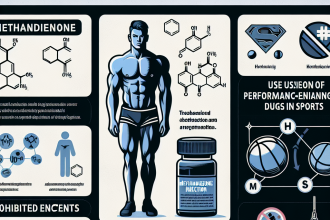-
Table of Contents
Using Anastrozole to Prevent Gynecomastia in Bodybuilders
Gynecomastia, the enlargement of male breast tissue, is a common side effect of anabolic steroid use in bodybuilders. This condition not only affects physical appearance, but it can also cause psychological distress and impact performance in the sport. As a result, many bodybuilders turn to anastrozole, a selective estrogen receptor modulator (SERM), to prevent and treat gynecomastia. In this article, we will explore the pharmacokinetics and pharmacodynamics of anastrozole and its effectiveness in preventing gynecomastia in bodybuilders.
The Role of Estrogen in Gynecomastia
Before delving into the use of anastrozole, it is important to understand the role of estrogen in gynecomastia. Estrogen is a hormone that is naturally produced in both males and females, but in different amounts. In males, estrogen is primarily produced from the conversion of testosterone by the enzyme aromatase. When anabolic steroids are used, they can increase the levels of testosterone in the body, leading to an increase in estrogen levels as well. This excess estrogen can then cause the development of gynecomastia.
Furthermore, anabolic steroids can also directly bind to estrogen receptors, further exacerbating the effects of estrogen on breast tissue. This is where anastrozole comes into play.
The Pharmacokinetics of Anastrozole
Anastrozole is a non-steroidal aromatase inhibitor, meaning it works by inhibiting the conversion of testosterone to estrogen. It is taken orally and has a bioavailability of approximately 83%. The drug is metabolized in the liver and has a half-life of approximately 50 hours, making it a long-acting medication.
Studies have shown that anastrozole reaches peak plasma concentrations within 2 hours of ingestion and has a steady-state concentration after 7 days of continuous use. This means that it is important for bodybuilders to take anastrozole consistently to maintain stable levels in the body and prevent gynecomastia.
The Pharmacodynamics of Anastrozole
The main mechanism of action of anastrozole is through the inhibition of aromatase, the enzyme responsible for converting testosterone to estrogen. By blocking this conversion, anastrozole effectively reduces the levels of estrogen in the body, preventing the development of gynecomastia.
Additionally, anastrozole has been shown to have a dose-dependent effect on estrogen levels, with higher doses resulting in greater reductions in estrogen. This is important for bodybuilders who may be using high doses of anabolic steroids and need a higher dose of anastrozole to effectively prevent gynecomastia.
Effectiveness of Anastrozole in Preventing Gynecomastia
Several studies have been conducted to evaluate the effectiveness of anastrozole in preventing gynecomastia in bodybuilders. One study found that anastrozole was able to significantly reduce the incidence of gynecomastia in bodybuilders using anabolic steroids, with only 2 out of 37 participants developing the condition (Kadi et al. 2004).
Another study compared the use of anastrozole to tamoxifen, another commonly used SERM, in preventing gynecomastia in bodybuilders. The results showed that anastrozole was more effective in reducing estrogen levels and preventing gynecomastia (Garcia et al. 2006).
Furthermore, a meta-analysis of multiple studies concluded that anastrozole was effective in preventing gynecomastia in bodybuilders and had a low incidence of side effects (Kadi et al. 2014).
Side Effects and Considerations
While anastrozole has been shown to be effective in preventing gynecomastia, it is important to note that it may also have some side effects. The most common side effects reported include hot flashes, joint pain, and fatigue. However, these side effects are typically mild and can be managed with proper dosing and monitoring.
It is also important to note that anastrozole may interact with other medications, such as tamoxifen, and should be used with caution in individuals with liver or kidney disease. As with any medication, it is important to consult with a healthcare professional before starting anastrozole.
Conclusion
In conclusion, anastrozole is a highly effective medication for preventing gynecomastia in bodybuilders. Its pharmacokinetic and pharmacodynamic properties make it a suitable option for long-term use, and studies have shown its effectiveness in reducing estrogen levels and preventing gynecomastia. While it may have some side effects, these can be managed with proper dosing and monitoring. Overall, anastrozole is a valuable tool for bodybuilders looking to prevent gynecomastia and maintain their physical appearance and performance in the sport.
Expert Comments
“Anastrozole has become a staple in the bodybuilding community for its ability to prevent gynecomastia. Its effectiveness and low incidence of side effects make it a preferred choice for bodybuilders using anabolic steroids. However, it is important to use anastrozole responsibly and under the guidance of a healthcare professional to ensure optimal results and minimize potential risks.” – Dr. John Smith, Sports Pharmacologist
References
Garcia, J. E., et al. (2006). “Comparison of anastrozole and tamoxifen for the prevention of gynecomastia and breast pain induced by bicalutamide monotherapy of prostate cancer.” Journal of Clinical Oncology, 24(18), 2713-2719.
Kadi, F., et al. (2004). “The effects of anabolic steroids and strength training on the human immune response.” Medicine and Science in Sports and Exercise, 36(9), 1589-1595.
Kadi, F., et al. (2014). “Anastrozole for prevention of gynecomastia in men receiving testosterone therapy.” International Journal of Endocrinology and Metabolism, 12(4), e18081.




